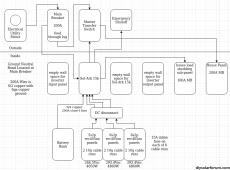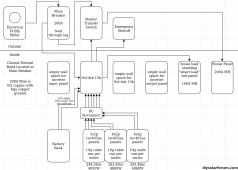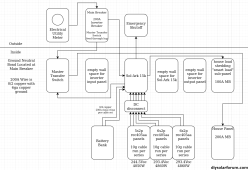prometheanfire
New Member
Hi all,
I've been lurking around and trying to figure things out for getting a vendor to install something both maintainable and expandable for the future (may need more than one 15k if I get an electric car or electrify more things around the house). Trying to do things by the book in Indiana...
Here's what I came up with.

The main question I have is if that load-shedding panel needs an exterior cutoff switch?
I also don't think I need the 15A fuses (panels can handle 25A as the max series fuse rating).
I should be able to fully isolate the sol-ark inverter from solar, ac input and ac output in case of failure. Helps to isolate strings on the roof as well.
The battery bank would be post-vendor install, probably 30kwh eg4-ll in a cabinet, possibly expand in the future as well.
As for roof layout I've photos here https://photos.app.goo.gl/Ly2vPfnm6zzJe4YT9
The main roof area faces about 200°S. The main thing I wonder is if I need optimizers due to clipping caused by the eastern roof ridge?
I'm heavily considering doing it myself, maybe permits with https://ignergy.com/ or another vendor, not sure, would still need to sub out an electrician for at least the main breaker install.
I've been lurking around and trying to figure things out for getting a vendor to install something both maintainable and expandable for the future (may need more than one 15k if I get an electric car or electrify more things around the house). Trying to do things by the book in Indiana...
Here's what I came up with.

The main question I have is if that load-shedding panel needs an exterior cutoff switch?
I also don't think I need the 15A fuses (panels can handle 25A as the max series fuse rating).
I should be able to fully isolate the sol-ark inverter from solar, ac input and ac output in case of failure. Helps to isolate strings on the roof as well.
The battery bank would be post-vendor install, probably 30kwh eg4-ll in a cabinet, possibly expand in the future as well.
As for roof layout I've photos here https://photos.app.goo.gl/Ly2vPfnm6zzJe4YT9
The main roof area faces about 200°S. The main thing I wonder is if I need optimizers due to clipping caused by the eastern roof ridge?
I'm heavily considering doing it myself, maybe permits with https://ignergy.com/ or another vendor, not sure, would still need to sub out an electrician for at least the main breaker install.






